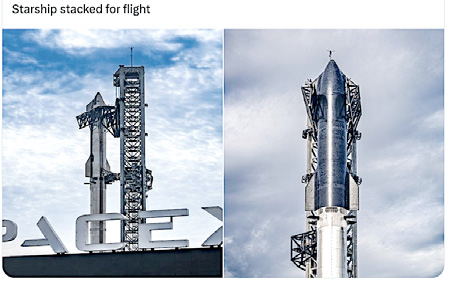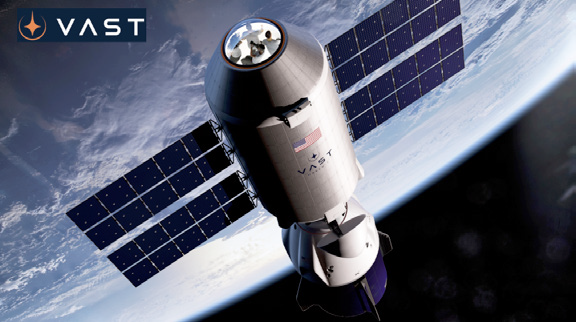The SpaceX Starship successfully launches
SpaceX launched its huge Starship rocket for the third time on Thursday, March 28th, from the company’s launch site in South Texas at 9:25 a.m. ET. on a key test flight to demonstrate new technologies and techniques that will be crucial on future missions to the moon and beyond.

Three minutes into the flight, the spacecraft separated from its booster as planned and then traveled further than it had on its previous test flights.
SpaceX lost communication with the vehicle before it successfully arrived at its planned splashdown location in the Indian Ocean.
The company confirmed roughly 10 minutes in that the spacecraft successfully reached orbit.
In a post on X (which, like SpaceX, is owned by Elon Musk), the Federal Aviation Administration (FAA) said it has “determined SpaceX met all safety, environmental, policy and financial responsibility requirements.”
While both of the first two Starship launches took off and achieved some mission goals, both also ended explosively.
The first one caused significant damage not only to the launchpad, but also “left a 385-acre debris field that flung concrete chunks as far as 2,680 feet from the launchpad and sparked a 3.5-acre fire.”

The FAA provided a list of 63 corrective actions for SpaceX to take to address issues such as leaking propellant before the second attempt last spring.
The flight is the rocket’s third and most ambitious such test, according to SpaceX.
The event was closely watched, as the nearly 400-foot-tall Starship,is expected to play an important part in NASA’s return-to-the-moon program.
Advantech launches Edge Generative AI system
Advantech has announced their successful Generative AI demo with the company’s MIC-733-AO, based on NVIDIA® Jetson AGX Orin™.

This event shows AI developers how to benefit from greater immediacy, enhanced security, and reduced internet costs when compared to cloud- based generative AI. The Generative AI models from the Jetson AI lab offers a free foundational AI model, enabling customization and significantly reducing development time with the MIC-733-AO Edge Generative AI System.
Advantech’s MIC-733-AO Edge Generative AI System, compatible with the NVIDIA Generative AI models from the Jetson AI lab, now efficiently runs large language models (LLMs), vision language model (VLM), vision transformers (ViT), and image generation and Llamaspeak at the edge, thanks to the inclusion of the NVIDIA® Jetson AGX Orin™.
The platform’s offerings span multiple layers, including accelerated computing, vital AI software, and pre-trained models, facilitating the creation, customization, and deployment of generative AI models suitable for various applications and locations.
With Generative AI models from the Jetson AI lab, developers can leverage the retrieval-augmented generation (RAG) technique, connecting LLMs and VLMs to a company’s knowledge base. This approach eliminates the need for traditional AI model training, allowing simple conversational interactions with the system to yield AI inferences, significantly shortening development time.
The Advantech MIC-733-AO offers high AI performance and multiple video interfaces, such as IP camera, USB/gigE industrial cameras, GMSL cameras, LiDAR, and more, enabling edge-based Generative AI model operation. Its exceptional thermal design prevents hot crashes, even when the NVIDIA® Jetson AGX Orin™ operates at full capacity.
Generative AI is revolutionizing human-computer interaction by creating new content from various inputs and outputs, such as text and images. The shift in demand from the cloud to the edge positions GenAI as ideal for high- responsiveness and low-latency environments.
Edge-based Generative AI offers several advantages over cloud-based solutions:
• Immediate Response: Edge computing systems, integrating data sources such as cameras and sensors, enable promote GenAI response without the delays associated with cloud uploads
• Information Security: Data remains within the edge system, avoiding the cybersecurity risks associated with cloud data transmission
• Stable Network Connection: Operable without a wireless network, the edge system stores data locally until network restoration, unlike cloud-based AI, which ceases function without a network
• Low Transmission Costs: Edge AI incurs no transmission costs if backend communication is unnecessary, needing only low-bandwidth transmission, more cost-effective than the higher bandwidth costs of cloud uploads.
Generative AI at the edge represents the future of the AI era. The MIC-733-AO Edge Generative AI System, integrated with the NVIDIA Generative AI models from the Jetson AI lab, offers a straightforward solution for AI developers and is now available on the market.
Cygnus cargo modules completed
Conceived in the 2000s, the first Cygnus pressurized cargo modules (PCM) were designed and built to ferry supplies to the International Space Station in the so-called standard version, with a payload capacity of 2,750 kg and a volume of 18 m3.

The Cygnus spacecraft comprises two main sections: a Service Module from Northrop Grumman, responsible for supplying the service to NASA, and a PCM developed and built by Thales Alenia Space.
Cygnus typically makes two trips a year to the International Space Station, ferrying food, water, spares, repairs and science experiments to the crew.
This initial configuration was the norm until the Cygnus developed for the OA-4 mission. From the fifth mission onward, the design and cargo capacity evolved significantly, with a larger version, able to hold 3,750 kg and a volume of 27 m3.
This enhanced configuration is the largest resupply capacity to the ISS, most recently used for the NG-20 mission at the end of January.
Inside Thales Alenia Space’s clean rooms, engineers are currently completing the Cygnus for NG-21, where final system verification and testing are underway to ready for delivery to Northrop Grumman in May of 2024.
In the meantime, work continues to complete PCM 22, already undergoing integration in the clean room.
Hawkeye 360 Advisory Board adds
HawkEye 360 Inc. has announced the new members of the firm’s Advisory Board, forming the Class of 2024. Retired Generals H. R. McMaster and David D. Thompson, two individuals with unique perspectives and vast experience, join for the first time, while Terry McAuliffe and Joan Dempsey return for another term.

David D. Thompson
“HawkEye 360 is delighted to introduce a stellar group of advisors for 2024,” said John Serafini, Chief Executive Officer of HawkEye 360. “Their wealth of experience and knowledge, spanning government, military, intelligence, and commercial sectors, is a testament to our unwavering commitment to excellence. Their invaluable contributions will propel our RF-sensing satellite network forward, a crucial step in providing the U.S. Government and our international allies with timely, critical data to combat illegal and unauthorized activities.”
General David D. Thompson (Ret.) brings 38 years of experience in the Air and Space Forces to his role, highlighted by his service as the first Vice Chief of Space Operations for the United States Space Force. In this capacity, he contributed to creating the Space
Force and represented the Chief of Space Operations in high-level meetings, including the Joint Chiefs of Staff. Thompson has commanded at squadron, group, and wing levels and has held senior positions at the National Reconnaissance Office, Air Force Warfare Center,
and United States Strategic Command. His education includes a Master of Science in National Security Industrial Policy from the Industrial College of the Armed Forces, a Master of Science in Aeronautics and Astronautics from Purdue University, and a Bachelor of Science in Astronautical Engineering from the United States Air Force Academy. Thompson’s career showcases his strategic planning and execution skills in national security and space operations.

H.R. McMaster
Lt. General H.R. McMaster (Ret.) is a soldier and scholar who brings a unique blend of strategic insights and global defense understanding to HawkEye 360.
McMaster served in the US Army for thirty-four years and commanded forces in combat in Afghanistan and Iraq before serving as the 25th Assistant to the President for National Security Affairs. He holds a Ph.D. in history from the University of North Carolina and authored two bestselling books. He is a Senior Fellow at the Hoover Institution, a fellow at the Freeman Spogli Institute, a lecturer at the Graduate School of Business at Stanford University, and a Distinguished Visiting Fellow at Arizona State University.
Joan Dempsey and Terry McAuliffe are welcomed back to the HawkEye 360 Advisory Board, each bringing a distinguished blend of experience and achievements to our team.
Joan offers unparalleled strategic insights with her extensive background in intelligence, security, and leadership roles at Booz Allen Hamilton and various high-level federal positions.
Terry, who was recognized for his dynamic tenure as the 72nd Governor of Virginia and his significant contributions to economic development and cybersecurity, brings a visionary approach to our mission. Together, their combined expertise and achievements will continue to guide HawkEye 360 in its strategic initiatives and further advancement in the industry.
These individuals, forming HawkEye 360 Advisory Board’s Class of 2024, will join the board’s 20 current members.
Globalsat Group’s strategic alliance
Globalsat Group has signed a strategic alliance through which Globalsat Central America and the Caribbean becomes a member of Globalsat Group.

Left to right, Globalsat Group executives: J. Alberto
Palacios, Chairman & CEO, and Juan Ramón Porras,
Managing Director for Central America & the Caribbean.
This agreement expands Globalsat Group’s reach, the foremost provider of pan- American mobile satellite services, offering current and future satellite service clients enhanced local presence in Central America and the Caribbean region, thereby increasing the consortium’s value in the field of mission-critical solutions and IoT.
As part of this agreement, Juan Ramón Porras, General Manager of Globalsat Central America and the Caribbean, joins Globalsat Group and will lead the emerging division. With a career spanning more than two decades, Mr. Porras has been a key figure in the satellite industry since 1997 when he began as Director of Operations at Globalstar Operations in Central America. He next assumed the role of General Manager for Latin America at Globalstar Inc. in 2006, expanding his responsibilities to include Brazil in 2008 and the remainder of the region in 2012. Mr. Porras brings vast knowledge and experience to Globalsat Group, acquired through his prolonged tenure in various key positions within the satellite sector.
Additionally, the new affiliate, Globalsat Central America and the Caribbean, will play a vital role in extending Globalsat Group’s reach and capabilities within these strategic regions. Leveraging local expertise and resources, the affiliate will spearhead initiatives to offer customized satellite solutions, particularly focusing on addressing the growing demands of IoT and mission-critical applications. This expansion marks a significant milestone in Globalsat Group’s commitment to serving diverse markets with innovative and reliable satellite solutions.
“By becoming part of Globalsat Group, we can now explore new opportunities with a broader portfolio of solutions, providing customers with the right tools to enhance their business productivity,” said Juan Ramón Porras.
J. Alberto Palacios, CEO of Globalsat Group, said, “We immediately realized that our shared vision and customeroriented philosophy are a perfect match, and therefore, we are now taking this potential to the next level. By enhancing our operations, we continue to increase our global presence and enhance our overall value in the satellite industry.”
Vast’s new advisor
Vast has announced the appointment of Clay Mowry as the company’s newest Advisor. Mowry’s career spans more than two decades in the commercial launch, satellite, and space station sectors.

As President of the International Astronautical Federation (IAF), Mowry is a globally recognized leader in the space community, within industry and government alike.
In his role as Advisor, Mowry will provide guidance and counsel on the growth of Vast’s commercial space station business.
Vast is executing its strategy to build a robust pipeline of international commercial and government customers for Haven-1, the world’s first commercial, free-flying, space station.
Vast is equally committed to increasing opportunities to collaborate with NASA on Private Astronaut Missions, Commercial LEO Destinations (CLD), and other flight opportunities as its space station fleet evolves.
Mowry brings a wealth of experience to inform and help refine that execution. From his time at Voyager he has extensive expertise in the CLD market, with a track record of building international partnerships, and from his time at Blue Origin he has unique experience pioneering sales in the human suborbital spaceflight market as well.

Clayton Mowry
Prior to joining Vast, Mowry held various leadership positions. In addition to the aforementioned Presidency of IAF, he was the Chief Revenue Officer at Voyager Space, Vice President for Global Sales at Blue Origin, and President and Chairman of Arianespace’s U.S. subsidiary. His multifaceted career has established him as a respected leader in the space industry.
“We are delighted to welcome Clay Mowry to Vast as an Advisor,” said Max Haot, CEO of Vast. “Clay’s experience and insight will be instrumental as we continue to push the boundaries of what’s possible in space habitation. His contribution will play a key role in supportint Vast’s strategic direction and driving our mission forward.”
“I am excited to join Vast as an Advisor and contribute to the company’s mission of advancing commercial space stations,” said Clay Mowry.”Vast’s commitment to execution is commendable, and I look forward to collaborating with the team to drive continued growth success in the rapidly evolving space station market.”


